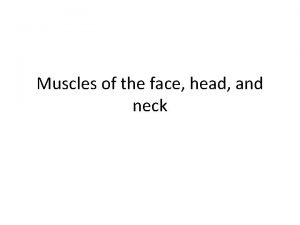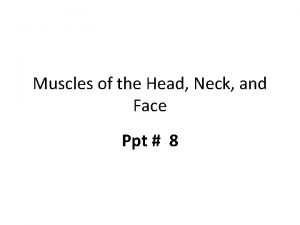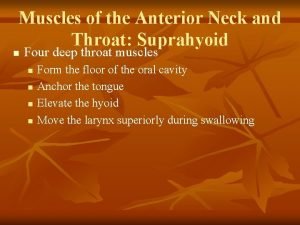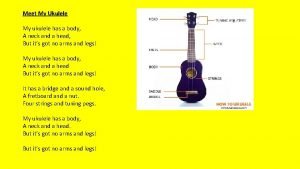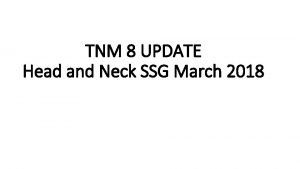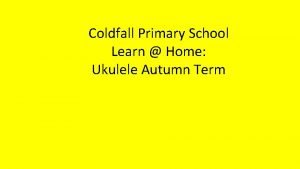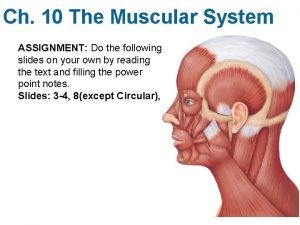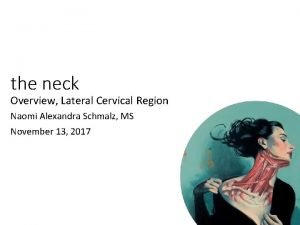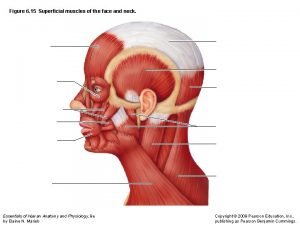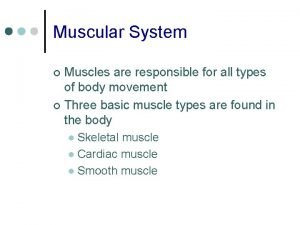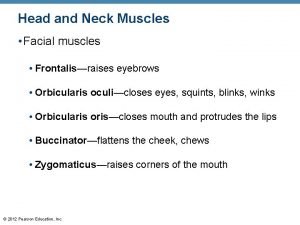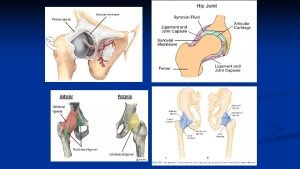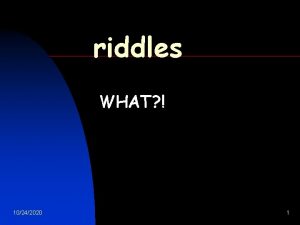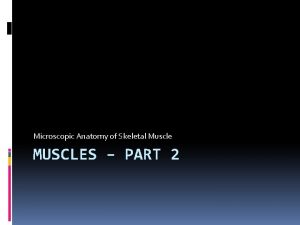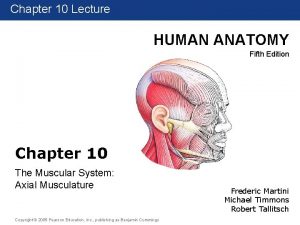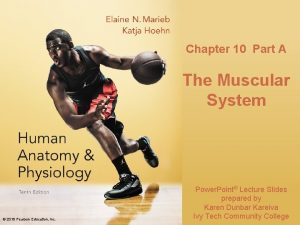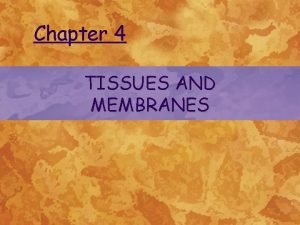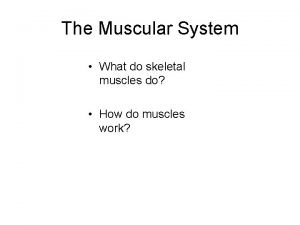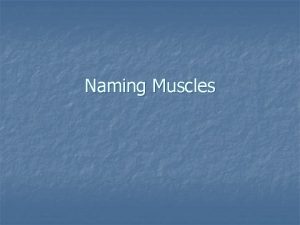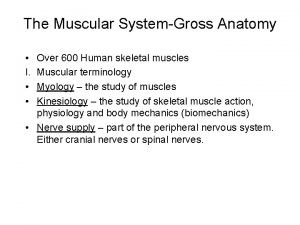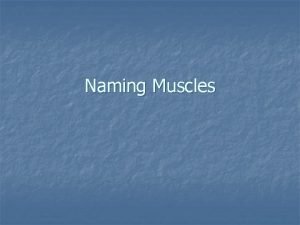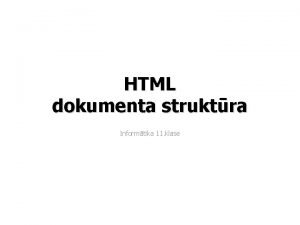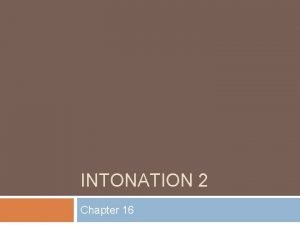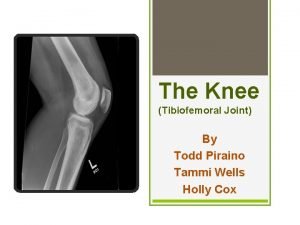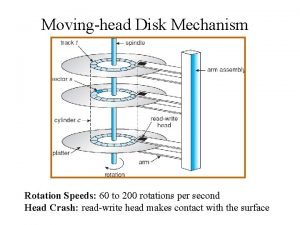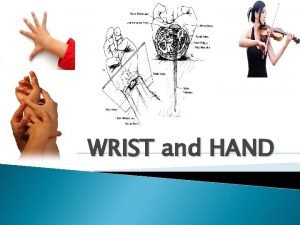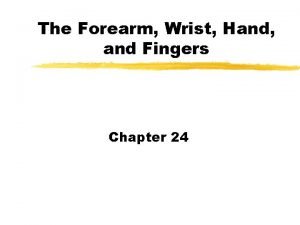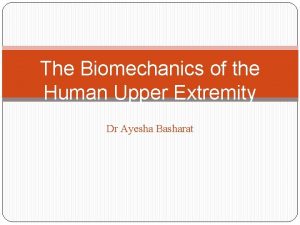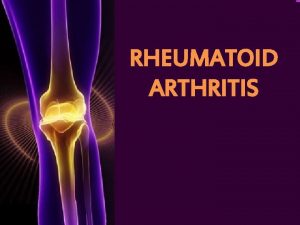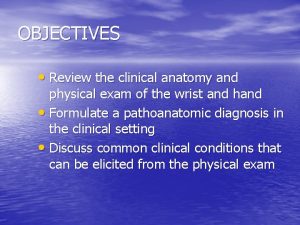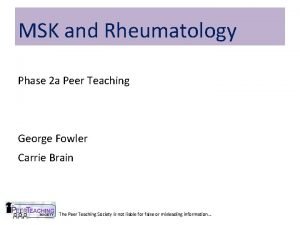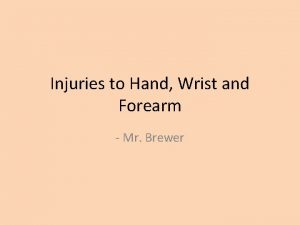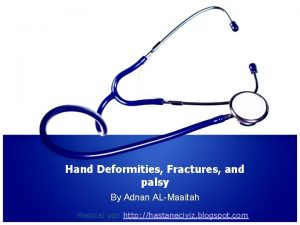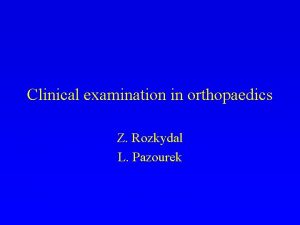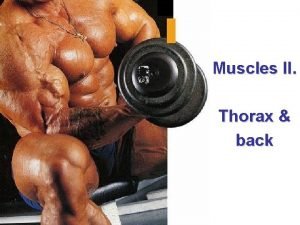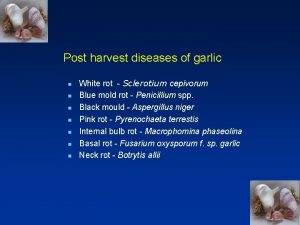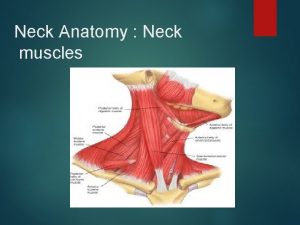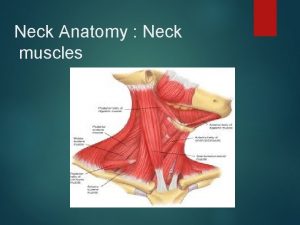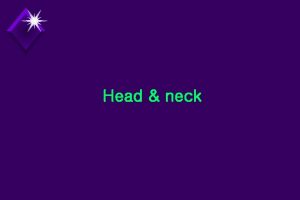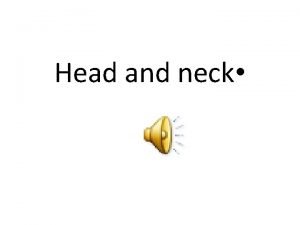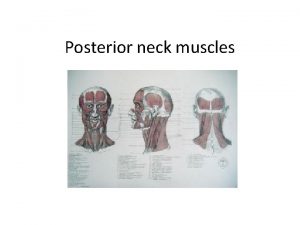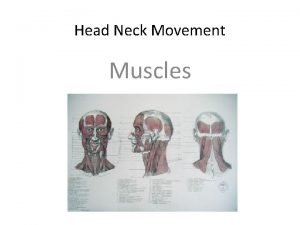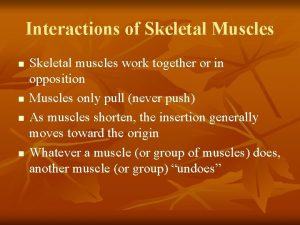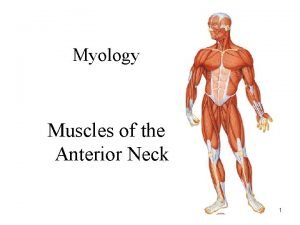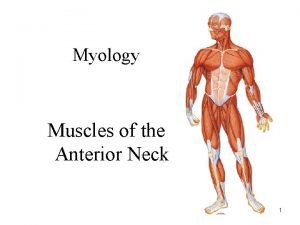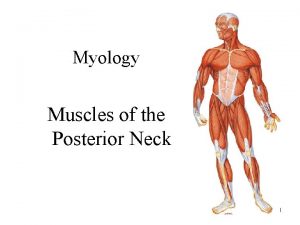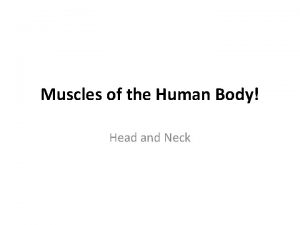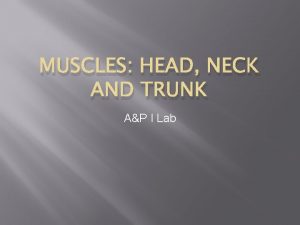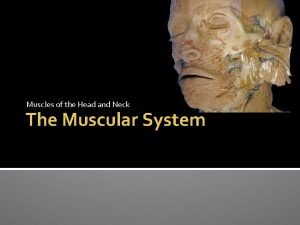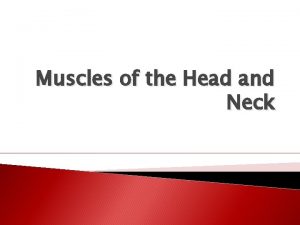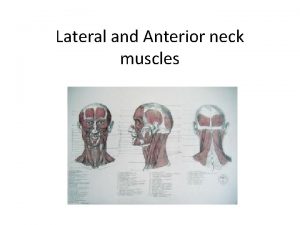Skeletal Muscles Muscles of the Head and Neck














































































- Slides: 78

Skeletal Muscles

Muscles of the Head and Neck • Expected Learning Outcomes – Name and locate the muscles that produce facial expression. – Name and locate the muscles used for chewing and swallowing. – Name and locate the neck muscles that move the head. – Identify the origin, insertion, action, and innervation of any of these muscles. 10 -2

Muscles of Facial Expression Copyright © The Mc. Graw-Hill Companies, Inc. Permission required for reproduction or display. Superficial Deep Galea aponeurotica Frontalis Corrugator supercilii Orbicularis oculi Nasalis Levator anguli oris Levator labii superioris Zygomaticus minor Zygomaticus major Masseter Risorius Buccinator Modiolus Orbicularis oris Depressor anguli oris Mentalis (cut) Depressor labii inferioris Platysma (a) Anterior view Figure 10. 8 a 10 -3

Muscles of Facial Expression Copyright © The Mc. Graw-Hill Companies, Inc. Permission required for reproduction or display. Galea aponeurotica Frontalis (cut) Temporalis Corrugator supercilii Orbicularis oculi Occipitalis Nasalis Levator labii superioris Zygomatic arch Zygomaticus minor Zygomaticus major Orbicularis oris Masseter Sternocleidomastoid Modiolus Levator scapulae Risorius (cut) Inferior pharyngeal constrictor Thyrohyoid Mentalis Sternothyroid Omohyoid Sternohyoid (b) Lateral view Figure 10. 8 b Depressor labii inferioris Depressor anguli oris Buccinator 10 -4

Muscles of Chewing and Swallowing • Extrinsic muscles of the tongue – – Tongue is very agile organ Pushes food between molars for chewing (mastication) Forces food into the pharynx for swallowing (deglutition) Crucial importance to speech • Intrinsic muscles of tongue – Vertical, transverse, and longitudinal fascicles Styloid process Palatoglossus Mastoid process Styloglossus Posterior belly of digastric (cut) Superior pharyngeal constrictor (cut) Inferior longitudinal muscle of tongue Stylohyoid Middle pharyngeal constrictor Genioglossus Hyoglossus Mylohyoid (cut) Hyoid bone Geniohyoid Larynx Inferior pharyngeal constrictor Trachea Esophagus Copyright © The Mc. Graw-Hill Companies, Inc. Permission required for reproduction or display. Figure 10. 9 10 -5

Muscles of Chewing and Swallowing • Four pairs of muscles produce the biting and chewing movements of the mandible – – – Copyright © The Mc. Graw-Hill Companies, Inc. Permission required for reproduction or display. Depression: to open mouth Elevation: biting and grinding Protraction: incisors can cut Retraction: make rear teeth meet Lateral and medial excursion: grind food Temporalis Orbicularis oris Buccinator Masseter (cut) (a) Lateral view • Temporalis, masseter, medial pterygoid, and lateral pterygoid Lateral pterygoid plate Medial pterygoid plate Lateral pterygoid muscle Medial pterygoid muscle Interior of oral cavity • Innervated by mandibular nerve, a branch of the trigeminal (CN V) (b) Posterior view Figure 10. 10 a, b 10 -6

Muscles of Chewing and Swallowing • • Hyoid muscles—suprahyoid group Aspects of chewing, swallowing, and vocalizing Eight pairs of hyoid muscles associated with hyoid bone Digastric—opens mouth widely Geniohyoid—depresses mandible Mylohyoid—elevates floor of mouth at beginning of swallowing Stylohyoid—elevates hyoid Copyright © The Mc. Graw-Hill Companies, Inc. Permission required for reproduction or display. Superficial Suprahyoid group Deep Digastric: Anterior belly Posterior belly Stylohyoid Mylohyoid Hyoid bone Common carotid artery Levator scapulae Infrahyoid group Internal jugular vein Thyrohyoid Sternohyoid Omohyoid: Superior belly Inferior belly Sternothyroid Sternocleidomastoid Infrahyoid group Clavicle (a) Anterior view Figure 10. 11 a 10 -7

Muscles of Chewing and Swallowing • • • Hyoid muscles—infrahyoid group Fix hyoid bone from below, allowing suprahyoid muscles to open mouth Omohyoid—depresses hyoid after elevation Sternohyoid—depresses hyoid after elevation Thyrohyoid—depresses hyoid and elevates larynx Sternothyroid—depresses larynx after elevation Copyright © The Mc. Graw-Hill Companies, Inc. Permission required for reproduction or display. Stylohyoid Digastric (posterior belly) Hyoglossus Splenius capitis Mylohyoid Inferior pharyngeal constrictor Digastric (anterior belly) Hyoid bone Sternocleidomastoid Trapezius Thyrohyoid Levator scapulae Omohyoid (superior belly) Sternothyroid Scalenes Omohyoid (inferior belly) Sternohyoid (b) Lateral view Figure 10. 11 b 10 -8

Muscles of Chewing and Swallowing Copyright © The Mc. Graw-Hill Companies, Inc. Permission required for reproduction or display. Styloid process Palatoglossus Mastoid process Styloglossus Posterior belly of digastric (cut) Superior pharyngeal constrictor (cut) Inferior longitudinal muscle of tongue Stylohyoid Middle pharyngeal constrictor Genioglossus Hyoglossus Mylohyoid (cut) Hyoid bone Geniohyoid Larynx Inferior pharyngeal constrictor Figure 10. 9 Trachea Esophagus • Pharynx: three pairs pharyngeal constrictors – Encircle pharynx forming a muscular funnel – During swallowing, drive food into the esophagus 10 -9

Muscles Acting on the Head • Originate on the vertebral column, thoracic cage, and pectoral girdle • Insert on the cranial bones • Actions – Flexion (tipping head forward) – Extension (holding the head erect) – Lateral flexion (tipping head to one side) – Rotation (turning the head to the left and right) 10 -10

Muscles Acting on the Head Copyright © The Mc. Graw-Hill Companies, Inc. Permission required for reproduction or display. • Neck flexors – Sternocleidomastoid – Scalenes Superior nuchal line Semispinalis capitis • Neck extensors – Trapezius – Splenius capitis – Semispinalis capitis Sternocleidomastoid Longissimus capitis Longissimus cervicis Trapezius Figure 10. 12 10 -11

Muscles Acting on the Head • May cause contralateral movement: movement of the head toward the opposite side • May cause ipsilateral movement: movement of the head toward the same side 10 -12

Muscles of the Trunk • Expected Learning Outcomes – Name and locate the muscles of respiration and explain how they affect airflow and abdominal pressure. – Name and locate the muscles of the abdominal wall, back, and pelvic floor. – Identify the origin, insertion, action, and innervation of any of these muscles. 10 -13

Muscles of the Trunk • Three functional groups – Muscles of respiration – Muscles that support abdominal wall and pelvic floor – Movement of vertebral column 10 -14

Muscles of Respiration • Breathing requires the use of muscles enclosing thoracic cavity – Diaphragm, external intercostal, internal intercostal, and innermost intercostal muscles • Inspiration—air intake • Expiration—expelling air 10 -15

Muscles of Respiration • Other muscles of chest and abdomen that contribute to breathing Sternocleidomastoid, scalenes of neck Pectoralis major and serratus anterior of chest Latissimus dorsi of back Abdominal muscles: internal and external obliques, and transverse abdominis – Some anal muscles – – 10 -16

Muscles of Respiration Copyright © The Mc. Graw-Hill Companies, Inc. Permission required for reproduction or display. • Diaphragm—muscular dome between thoracic and abdominal cavities • Muscle fascicles extend to a fibrous central tendon • Contraction flattens diaphragm Xiphoid process of sternum Inferior vena cava Ribs Esophagus Central tendon of diaphragm – Enlarges thoracic cavity (inspiration) • In relaxation of diaphragm it rises – Shrinks the thoracic cavity (expiration) Aorta Vertebral column (b) Inferior view of diaphragm Figure 10. 13 b 10 -17

Muscles of Respiration • External intercostals Copyright © The Mc. Graw-Hill Companies, Inc. Permission required for reproduction or display. – Elevate ribs – Expand thoracic cavity – Create partial vacuum causing inflow of air External intercostals • Internal intercostals – Depresses and retracts ribs – Compresses thoracic cavity – Expelling air • Innermost intercostals – Same action as internal intercostals Internal intercostals (a) Lateral view of intercostal muscles Figure 10. 13 a 10 -18

Muscles of the Anterior Abdominal Wall • Internal abdominal oblique – Intermediate layer of lateral abdominal muscles – Unilateral contraction causes ipsilateral rotation of waist – Aponeurosis • Tendons of oblique and transverse muscles • Broad, fibrous sheets Copyright © The Mc. Graw-Hill Companies, Inc. Permission required for reproduction or display. Subclavius Pectoralis minor (cut) Pectoralis minor Internal intercostals Serratus anterior External intercostals Rectus abdominis (cut) Rectus sheath External abdominal oblique (cut) Internal abdominal oblique Posterior wall of rectus sheath (rectus abdominis removed) Inguinal ligament Transverse abdominal (cut) (b) Deep Figure 10. 15 b 10 -19

Muscles of the Anterior Abdominal Wall • Transverse abdominal – – Deepest of lateral abdominal muscles Horizontal fibers Compresses abdominal contents Contributes to movements of vertebral column Copyright © The Mc. Graw-Hill Companies, Inc. Permission required for reproduction or display. Subclavius Pectoralis minor (cut) Pectoralis minor Internal intercostals Serratus anterior External intercostals Rectus abdominis (cut) Rectus sheath External abdominal oblique (cut) Internal abdominal oblique Posterior wall of rectus sheath (rectus abdominis removed) Inguinal ligament Transverse abdominal (cut) (b) Deep Figure 10. 15 b 10 -20

Muscles of the Anterior Abdominal Wall • Rectus abdominis – – – Flexes lumbar region of vertebral column Produces forward bending at the waist Extends from sternum to pubis Rectus sheath encloses muscle Three transverse tendinous intersections divide rectus abdominis into segments, sometimes called a “six pack” Copyright © The Mc. Graw-Hill Companies, Inc. Permission required for reproduction or display. Pectoralis major Latissimus dorsi Serratus anterior Tendinous intersections Rectus sheath (cut edges) Rectus sheath Transverse abdominal Umbilicus Internal abdominal oblique (cut) Linea semilunaris Linea alba External abdominal oblique (cut) Rectus abdominis Aponeurosis of external abdominal oblique Inguinal ligament (a) Superficial Figure 10. 15 a 10 -21

Muscles of Back Copyright © The Mc. Graw-Hill Companies, Inc. Permission required for reproduction or display. Superficial Deep • Superficial muscles Semispinalis capitis Sternocleidomastoid Splenius capitis Trapezius Levator scapulae Rhomboideus minor Rhomboideus major Supraspinatus Infraspinatus Teres minor Deltoid Teres major Serratus anterior Erector spinae Serratus posterior inferior External abdominal oblique Latissimus dorsi External abdominal oblique Thoracolumbar fascia Internal abdominal oblique Gluteus medius Gluteus minimus Gluteus maximus • Extend, rotate, and laterally flex vertebral column • Most prominent: latissimus dorsi and trapezius • Upper limb movement Lateral rotators Figure 10. 17 10 -22

Muscles of the Back Copyright © The Mc. Graw-Hill Companies, Inc. Permission required for reproduction or display. • Deep muscles • Erector spinae – Iliocostalis, longissimus, spinalis – From cranium to sacrum – Extension and lateral flexion of vertebral column • Semispinalis thoracis – Extension and contralateral rotation of vertebral column Superior nuchal line Semispinalis capitis Longissimus capitis Splenius capitis Semispinalis cervicis Serratus posterior superior Splenius cervicis Semispinalis thoracis Erector spinae: Iliocostalis Longissimus Spinalis Serratus posterior inferior Multifidus Internal abdominal oblique Quadratus lumborum External abdominal oblique (cut) Figure 10. 18 10 -23

Muscles of the Back Cont. • Quadratus lumborum – Aids respiration – Ipsilateral flexion of lumbar vertebral column • Multifidus – Stabilizes adjacent vertebrae – Maintains posture

Muscles of the Pelvic Floor • Three layers of muscles and fasciae that span pelvic outlet – Penetrated by anal canal, urethra, and vagina • Perineum—diamond-shaped region between the thighs – Bordered by four bony landmarks • Pubic symphysis anteriorly • Coccyx posteriorly • Ischial tuberosities laterally – Urogenital triangle: anterior half of perineum – Anal triangle: posterior half of perineum 10 -25

Muscles of the Pelvic Floor • Three layers or compartments of the perineum – Superficial perineal space: three muscles • Ischiocavernosus, bulbospongiosus, superficial transverse peritoneal – Middle compartment: spanned by urogenital diaphragm • Composed of a fibrous membrane and two or three muscles • Deep transverse perineal muscle, external urethral and anal sphincters • Compressor urethrae in females only – Pelvic diaphragm: deepest layer consists of two muscle pairs • Levator ani and coccygeus 10 -26

Muscles of the Pelvic Floor Copyright © The Mc. Graw-Hill Companies, Inc. Permission required for reproduction or display. Male Ischiocavernosus Perineal raphe Bulbospongiosus Superficial transverse perineal muscle Levator ani Figure 10. 20 a Gluteus maximus (a) Superficial perineal space, inferior view © The Mc. Graw-Hill Companies, Inc. /Rebecca Gray, photographer/Don Kincaid, dissections • • • Superficial perineal space Three muscles found just deep to the skin Ischiocavernosus—maintains erection Bulbospongiosus—aids in erection, expels remaining urine Superficial transverse perineal—not always present 10 -27

Muscles of the Pelvic Floor Copyright © The Mc. Graw-Hill Companies, Inc. Permission required for reproduction or display. Female Ischiocavernosus Perineal raphe Bulbospongiosus Urogenital triangle Urethra Vagina Superficial transverse perineal muscle Levator ani Anus Gluteus maximus Anal triangle Figure 10. 20 a (a) Superficial perineal space, inferior view © The Mc. Graw-Hill Companies, Inc. /Rebecca Gray, photographer/Don Kincaid, dissections • Middle compartment • Urogenital triangle—middle layer of pelvic floor; contains urogenital diaphragm: deep transverse muscle and external urethral sphincter • Anal triangle—external anal sphincter 10 -28

Muscles of the Pelvic Floor Copyright © The Mc. Graw-Hill Companies, Inc. Permission required for reproduction or display. Pubic symphysis Pubic ramus External urethral sphincter Deep transverse perineal muscle Perineal body External anal sphincter Figure 10. 20 b (b) Urogenital diaphragm, inferior view • Pelvic diaphragm • Deepest compartment of the perineum • Two muscle pairs – Levator ani: supports viscera and defecation – Coccygeus: supports and elevates pelvic floor 10 -29

Hernias • Hernia—any condition in which the viscera protrudes through a weak point in the muscular wall of the abdominopelvic cavity Copyright © The Mc. Graw-Hill Companies, Inc. Permission required for reproduction or display. Aponeurosis of external abdominal oblique muscle Inguinal canal • Inguinal hernia External inguinal ring – Most common type of hernia (rare in women) – Viscera enter inguinal canal or even the scrotum Herniated loop of small intestine Upper scrotum • Hiatal hernia – Stomach protrudes through diaphragm into thorax – Overweight people over 40 Figure 10. 21 • Umbilical hernia – Viscera protrude through the navel 10 -30

Muscles Acting on the Shoulder and Upper Limb • Expected Learning Outcomes – Name and locate the muscles that act on the pectoral girdle, shoulder, elbow, wrist, and hand. – Relate the actions of these muscles to the joint movements described in chapter 9. – Describe the origin, insertion, and innervation of each muscle. 10 -31

Muscles Acting on the Shoulder and Upper Limb • Compartments—spaces in which muscles are organized and are separated by fibrous connective tissue sheets (fasciae) – Each compartment contains one or more functionally related muscles along with their nerve and blood supplies • Muscles of upper limbs divided into anterior and posterior compartments • Muscles of lower limbs divided into anterior, posterior, medial, and lateral compartments • Intermuscular septa (thick fascia) separates compartments • Compartment syndrome—one of the muscles or blood vessels in a compartment is injured 10 -32

Compartment Syndrome • Fasciae of arms and legs enclose muscle compartments very snugly • If a blood vessel in a compartment is damaged, blood and tissue fluid accumulate in the compartment • Fasciae prevent compartment from expanding with increasing pressure • Compartment syndrome—mounting pressure on the muscles, nerves, and blood vessels triggers a sequence of degenerative events – Blood flow to compartment is obstructed by pressure 10 -33

Compartment Syndrome Cont. – If ischemia (poor blood flow) persists for more than 2 to 4 hours, nerves begin to die – After 6 hours, muscles begin to die • Nerves can regenerate after pressure relieved, but muscle damage is permanent • Myoglobin in urine indicates compartment syndrome • Treatment: immobilization of limb and fasciotomy (incision to relieve compartment pressure) 10 -34

Muscles Acting on the Shoulder and Upper Limb • Upper limb is used for a broad range of powerful and subtle actions – Climbing, grasping, throwing, writing, playing musical instruments, and manipulating small objects • • • Muscles that act on the scapula Muscles that act on the humerus and shoulder joint Muscles that act on the forearm and elbow joint Intrinsic—forearm Extrinsic—hand 10 -35

Muscles Acting on the Shoulder • Originate on the axial skeleton • Insert on clavicle and scapula • Scapula loosely attached to thoracic cage – Capable of great movement – Rotation, elevation, depression, protraction, retraction • Clavicle braces the shoulder and moderates movements 10 -36

Muscles Acting on the Scapula Copyright © The Mc. Graw-Hill Companies, Inc. Permission required for reproduction or display. Lateral rotation Trapezius (superior part) Serratus anterior Elevation Levator scapulae Trapezius (superior part) Rhomboideus major Rhomboideus minor Medial rotation Levator scapulae Rhomboideus major Rhomboideus minor Depression Trapezius (inferior part) Serratus anterior Retraction Rhomboideus major Rhomboideus minor Trapezius Protraction Pectoralis minor Serratus anterior Figure 10. 22 10 -37

Muscles Acting on the Shoulder • Anterior group of muscles of pectoral girdle • Serratus anterior • Pectoralis minor – Rbs 1– 9 to medial border of scapula – Abducts and rotates or depresses scapula – Ribs 3– 5 to coracoid process of scapula – Draws scapula laterally Copyright © The Mc. Graw-Hill Companies, Inc. Permission required for reproduction or display. Subclavius Pectoralis minor (cut) Pectoralis minor Internal intercostals Serratus anterior External intercostals Rectus abdominis (cut) Rectus sheath External abdominal oblique (cut) Internal abdominal oblique Posterior wall of rectus sheath (rectus abdominis removed) Inguinal ligament Transverse abdominal (cut) (b) Deep Figure 10. 15 b 10 -38

Muscles Acting on the Shoulder • Posterior group of muscles of pectoral girdle Copyright © The Mc. Graw-Hill Companies, Inc. Permission required for reproduction or display. Superficial Deep • Four muscles of posterior group – Trapezius: superficial – Levator scapulae, rhomboideus minor, and rhomboideus major: deep Semispinalis capitis Sternocleidomastoid Splenius capitis Trapezius Levator scapulae Rhomboideus minor Rhomboideus major Supraspinatus Infraspinatus Teres minor Deltoid Teres major • Trapezius Serratus anterior Erector spinae Serratus posterior inferior Latissimus dorsi External abdominal oblique Thoracolumbar fascia Internal abdominal oblique Gluteus medius Gluteus minimus – Stabilizes scapula and shoulder – Elevates and depresses shoulder apex Gluteus maximus Lateral rotators Figure 10. 17 10 -39

Muscles Acting on the Shoulder Cont. • Levator scapulae – Elevates scapula – Flexes neck laterally • Rhomboideus minor – Retracts scapula and braces shoulder • Rhomboideus major – Same as rhomboideus minor

Muscles Acting on the Arm • Nine muscles cross the shoulder joint and insert on humerus • Two are axial muscles because they originate on axial skeleton – Pectoralis major: flexes, adducts, and medially rotates humerus – Latissimus dorsi: adducts and medially rotates humerus Copyright © The Mc. Graw-Hill Companies, Inc. Permission required for reproduction or display. Supraspinatus Deltoid Clavicle Spine of scapula Sternum Greater tubercle of humerus Infraspinatus Humerus Pectoralis major Teres minor Teres major Triceps brachii: Coracobrachialis Triceps brachii: Lateral head Long head Medial head Biceps brachii Latissimus dorsi Brachialis Brachioradialis (a) Anterior view Figure 10. 23 a (b) Posterior view Figure 10. 23 b 10 -41

Muscles Acting on the Shoulder • Posterior scapular muscles Copyright © The Mc. Graw-Hill Companies, Inc. Permission required for reproduction or display. Superficial Deep Semispinalis capitis Sternocleidomastoid Splenius capitis Trapezius Levator scapulae Rhomboideus minor Rhomboideus major Supraspinatus Deltoid Infraspinatus Teres minor Teres major Erector spinae Serratus anterior Serratus posterior inferior Latissimus dorsi External abdominal oblique Thoracolumbar fascia Internal abdominal oblique Gluteus medius Gluteus minimus Gluteus maximus Lateral rotators Figure 10. 17 10 -42

Muscles Acting on the Arm Copyright © The Mc. Graw-Hill Companies, Inc. Permission required for reproduction or display. • Seven scapular muscles • Originate on scapula – Deltoid • Rotates and abducts arm • Intramuscular injection site – Teres major • Extension and medial rotation of humerus – Coracobrachialis • Flexes and medially rotates arm Clavicle Sternum Deltoid Pectoralis major Triceps brachii: Lateral head Long head Medial head Coracobrachialis Biceps brachii Brachialis Brachioradialis Figure 10. 23 a (a) Anterior view Copyright © The Mc. Graw-Hill Companies, Inc. Permission required for reproduction or display. Supraspinatus Spine of scapula Greater tubercle of humerus Infraspinatus Humerus Teres minor Teres major – Remaining four form the rotator cuff that reinforce the shoulder joint Triceps brachii: Lateral head Long head Latissimus dorsi Figure 10. 23 b (b) Posterior view 10 -43

Anterior View of Cadaver Chest Copyright © The Mc. Graw-Hill Companies, Inc. Permission required for reproduction or display. Deltoid Pectoralis major Biceps brachii: Long head Short head Serratus anterior External abdominal oblique (a) Anterior view © The Mc. Graw-Hill Companies, Inc. /Rebecca Gray, photographer/Don Kincaid, dissections Figure 10. 24 a 10 -44

Back Muscles of Cadaver Copyright © The Mc. Graw-Hill Companies, Inc. Permission required for reproduction or display. Levator scapulae Rhomboideus minor Rhomboideus major Deltoid Infraspinatus Teres minor Medial border of scapula Teres major Triceps brachii: Lateral head Long head Latissimus dorsi (b) Posterior view © The Mc. Graw-Hill Companies, Inc. /Rebecca Gray, photographer/Don Kincaid, dissections Figure 10. 24 b 10 -45

Muscles Acting on the Arm • Rotator cuff muscles • Tendons of the remaining four scapular muscles form the rotator cuff • Acronym “SITS muscles” – Supraspinatus – Infraspinatus – Teres minor – Subscapularis • Tendons of these muscles merge with the joint capsule of the shoulder as they cross it in route to the humerus • Holds head of humerus into glenoid cavity • Supraspinatus tendon most easily damaged 10 -46

Rotator Cuff Muscles Copyright © The Mc. Graw-Hill Companies, Inc. Permission required for reproduction or display. Anterior Rotator cuff (SITS) muscles: Supraspinatus Infraspinatus Teres minor Posterior Clavicle Acromion Coracoid process Glenoid cavity Subscapularis Inferior angle Figure 10. 25 10 -47

Muscles Acting on the Forearm • Elbow and forearm capable of flexion, extension, pronation, and supination – Carried out by muscles in both brachium (arm) and antebrachium (forearm) • Muscles with bellies in the arm (brachium) – Principal elbow flexors: anterior compartment • Brachialis and biceps brachii – Brachialis produces 50% more power than biceps brachii – Brachialis is prime mover of elbow flexion – Principal elbow extensor: posterior compartment • Triceps brachii – Prime mover of elbow extension 10 -48

Muscles Acting on the Forearm • Muscles with bellies in the forearm (antebrachium) • Most forearm muscles act on the hand wrist – – – Brachioradialis: flexes elbow Anconeus: extends elbow Pronator quadratus: prime mover in forearm pronation Pronator teres: assists pronator quadratus in pronation Supinator: supinates the forearm 10 -49

Muscles Acting on the Forearm Copyright © The Mc. Graw-Hill Companies, Inc. Permission required for reproduction or display. Figure 10. 23 c • Principal flexor – Brachialis Biceps brachii: Long head Short head Copyright © The Mc. Graw-Hill Companies, Inc. Permission required for reproduction or display. • Synergistic flexors – Biceps brachii – Brachioradialis Clavicle Sternum Deltoid Pectoralis major Triceps brachii: Lateral head Long head Medial head Biceps brachii Brachialis Brachioradialis Coracobrachialis (c) Anterior view Copyright © The Mc. Graw-Hill Companies, Inc. Permission required for reproduction or display. Supraspinatus • Principal extensor – Triceps brachii Spine of scapula Greater tubercle of humerus Infraspinatus Humerus Teres minor (a) Anterior view Teres major Figure 10. 23 a Triceps brachii: Lateral head Long head Latissimus dorsi Figure 10. 23 b (b) Posterior view 10 -50

Muscles Acting on the Forearm Copyright © The Mc. Graw-Hill Companies, Inc. Permission required for reproduction or display. Lateral epicondyle Medial epicondyle Supinator Pronator teres Ulna Radius Pronator quadratus Biceps brachii Radius Bursa Supinator Ulna (b) Muscle actions in supination (c) Pronation (a) Supination Figure 10. 26 a • Supination – Supinator muscle – Palm facing anteriorly or superiorly Figure 10. 26 c • Pronation – Pronator quadratus and pronator teres – Palm faces posteriorly or inferiorly 10 -51

Muscles Acting on the Wrist and Hand • • Anterior group Extrinsic muscles of the forearm Intrinsic muscles in the hand itself Extrinsic muscle actions – – Flexion and extension of wrist and digits Radial and ulnar flexion Finger abduction and adduction Thumb opposition Copyright © The Mc. Graw-Hill Companies, Inc. Permission required for reproduction or display. Biceps brachii Triceps brachii Brachialis Common flexor tendon Pronator teres Aponeurosis of biceps brachii Brachioradialis Flexor carpi radialis Palmaris longus Flexor carpi ulnaris Anterior view Interosseous membrane Extensor carpi radialis longus and brevis Flexor digitorum superficialis Flexor retinaculum Figure 10. 28 a, b, c Palmar aponeurosis (a) Superficial flexors (b) Intermediate flexor Supinator Flexor digitorum superficialis Flexor digitorum profundus Flexor pollicis longus Flexor digitorum superficialis tendons Flexor digitorum profundus tendons (c) Deep flexors 10 -52

Muscles Acting on the Wrist and Hand • Anterior (flexor) compartment—superficial layer – – Flexor carpi radialis Flexor carpi ulnaris Flexor digitorum superficialis Palmaris longus • Anterior (flexor) compartment—deep layer – Flexor digitorum profundus – Flexor pollicis longus 10 -53

Cross Section of Upper Limb Copyright © The Mc. Graw-Hill Companies, Inc. Permission required for reproduction or display. Deltoid Pectoralis major Biceps brachii: Short head Long head (a) Coracobrachialis Humerus Latissimus dorsi tendon (b) Teres major Triceps brachii: Lateral head Long head (c) (a) Anterior Biceps brachii Lateral Medial Brachialis Posterior Triceps brachii: Medial head Long head Lateral head Key Anterior (flexor) compartment, superficial Anterior (flexor) compartment, deep Posterior (extensor) compartment (b) Other muscles Supinator Pronator teres Flexor carpi radialis Palmaris longus Radius Flexor digitorum superficialis Brachioradialis Figure 10. 27 a, b, c Extensor carpi radialis longus Flexor pollicis longus Flexor carpi ulnaris Extensor carpi radialis brevis Extensor digitorum Flexor digitorum profundus Ulna Anconeus Extensor digiti minimi Extensor carpi ulnaris (c) 10 -54

Muscles Acting on the Wrist and Hand • • Posterior group Extension of wrist and fingers, adduct/abduct wrist Extension and abduction of thumb (pollicis) Brevis means “short, ” ulnaris indicates “on ulna side of forearm” Copyright © The Mc. Graw-Hill Companies, Inc. Permission required for reproduction or display. Triceps brachii Brachioradialis Anconeus Posterior view Olecranon Extensor carpi radialis longus Supinator Extensor carpi radialis brevis Flexor carpi ulnaris Abductor pollicis longus Extensor digitorum Extensor carpi ulnaris Abductor pollicis longus Extensor digiti minimi Extensor pollicis brevis Anconeus Extensor pollicis longus Extensor pollicis brevis Extensor indicis Extensor pollicis longus Tendon of extensor indicis Tendons of extensor carpi radialis longus and brevis Tendons of extensor digitorum Figure 10. 29 a, b (a) Superficial extensors (b) Deep extensors 10 -55

Muscles Acting on the Wrist and Hand • Posterior (extensor) compartment—superficial layer – – – Extensor carpi radialis longus Extensor carpi radialis brevis Extensor digitorum Extensor digiti minimi Extensor carpi ulnaris • Posterior (extensor) compartment—deep layer – – Abductor pollicis longus Extensor pollicis brevis Extensor pollicis longus Extensor indicis 10 -56

Carpal Tunnel Syndrome • Flexor retinaculum—bracelet-like fibrous sheet, which the flexor tendons of the extrinsic muscles that flex the wrist pass on their way to their insertions • Carpal tunnel—tight space between the flexor retinaculum and the carpal bones – Flexor tendons passing through the tunnel are enclosed in tendon sheaths • Enable tendons to slide back and forth quite easily 10 -57

Carpal Tunnel Syndrome • Carpal tunnel syndrome—prolonged, repetitive motions of wrist and fingers can cause tissues in the carpal tunnel to become inflamed, swollen, or fibrotic – Puts pressure on the median nerve of the wrist that passes through the carpal tunnel along with the flexor tendons – Tingling and muscular weakness in the palm and medial side of the hand – Pain may radiate to arm and shoulder – Treatment: anti-inflammatory drugs, immobilization of the wrist, and sometimes surgery to remove part or all of flexor retinaculum 10 -58

Carpal Tunnel Syndrome Copyright © The Mc. Graw-Hill Companies, Inc. Permission required for reproduction or display. Tendon of flexor digitorum superficialis Lumbrical Opponens digiti minimi Repetitive motions cause inflammation and pressure on median nerve Copyright © The Mc. Graw-Hill Companies, Inc. Permission required for reproduction or display. Adductor pollicis Flexor digiti minimi brevis Flexor pollicis brevis Abductor digiti minimi Abductor pollicis brevis Pisiform bone Tendon of extensor pollicis brevis Flexor digitorum superficialis Tendon of flexor carpi radialis Tendon sheath First dorsal interosseous Tendon of flexor digitorum profundus Adductor pollicis Tendon of flexor digitorum superficialis Tendon of flexor pollicis longus Lumbricals Opponens digiti minimi Flexor pollicis brevis Flexor digiti minimi brevis Abductor pollicis brevis Abductor digiti minimi Opponens pollicis Flexor retinaculum (b) Palmar dissection, superficial Figure 10. 31 b Tendons of: Abductor pollicis longus Flexor carpi radialis Flexor pollicis longus Tendons of: Flexor carpi ulnaris Flexor digitorum superficialis Palmaris longus (a) Palmar aspect, superficial Figure 10. 31 a 10 -59

Intrinsic Muscles of the Hand • Thenar group—form thick, fleshy mass at base of thumb – – Adductor pollicis Abductor pollicis brevis Flexor pollicis brevis Opponens pollicis • Hypothenar group—fleshy base of the little finger – Abductor digiti minimi – Flexor digiti minimi brevis – Opponens digiti minimi • Midpalmar group—hollow of palm – Dorsal interosseous muscles (4) – Palmar interosseous muscles (3) – Lumbricals (4 muscles)

Muscles Acting on the Hip and Lower Limb • Expected Learning Outcomes – Name and locate the muscles that act on the hip, knee, ankle, and toe joints. – Relate the actions of these muscles to the joint movements described in chapter 9. – Describe the origin, insertion, and innervation of each muscle. 10 -61

Muscles Acting on the Hip and Lower Limb • Largest muscles found in lower limb • Less for precision, more for strength needed to stand, maintain balance, walk, and run • Several cross and act on two or more joints • Leg—the part of the limb between the knee and ankle • Foot—includes tarsal region (ankle), metatarsal region, and the toes 10 -62

Muscles Acting on the Hip and Femur Copyright © The Mc. Graw-Hill Companies, Inc. Permission required for reproduction or display. • Anterior muscles of the hip – Iliacus • Flexes thigh at hip • Iliacus portion arises from iliac crest and fossa – Psoas major • Flexes thigh at hip • Arises from lumbar vertebrae – They share a common tendon on the femur Iliopsoas: Iliacus Psoas major Pectineus Adductor magnus Adductor brevis Adductor longus Piriformis Obturator externus Gracilis Insertion of gracilis on tibia Figure 10. 32 10 -63

Muscles Acting on the Hip and Femur • Lateral and posterior muscles of the hip – Tensor fasciae latae • Extends knee, laterally rotates knee – Gluteus maximus • Forms mass of the buttock • Prime hip extensor • Provides most of lift when you climb stairs Copyright © The Mc. Graw-Hill Companies, Inc. Permission required for reproduction or display. Superficial Deep Iliac crest Gluteus minimus Gluteus medius Lateral rotators: Piriformis Sacrum Gluteus maximus Gemellus superior Obturator internus Obturator externus Gemellus inferior Coccyx Ischial tuberosity Quadratus femoris – Gluteus medius and minimus • Abduct and medially rotate thigh Figure 10. 33 10 -64

Muscles Acting on the Hip and Femur • Posterior group • Lateral rotators—six muscles inferior to gluteus minimus • Deep to the two other gluteal muscles – – – Gemellus superior Gemellus inferior Obturator externus Obturator internus Piriformis Quadratus femoris

Muscles Acting on the Hip and Femur Copyright © The Mc. Graw-Hill Companies, Inc. Permission required for reproduction or display. • Medial (adductor) compartment of thigh • Five muscles act as primary adductors of the thigh – – – Adductor brevis Adductor longus Adductor magnus Gracilis Pectineus Iliopsoas: Iliacus Psoas major Piriformis Pectineus Obturator externus Adductor magnus Adductor brevis Adductor longus Gracilis Insertion of gracilis on tibia Figure 10. 32 10 -66

Muscles Acting on the Knee and Leg • Anterior (extensor) compartment of the thigh – Contains large quadriceps femoris muscle • Prime mover of knee extension • Most powerful muscle in the body • Has four heads—rectus femoris, vastus lateralis, vastus medialis, and vastus intermedius – – All converge on single quadriceps (patellar) tendon Extends to patella Then continues as patellar ligament Inserts on tibial tuberosity – Sartorius: longest muscle in the body • “Tailor’s muscle” 10 -67

Anterior Thigh Cadaver Muscles Copyright © The Mc. Graw-Hill Companies, Inc. Permission required for reproduction or display. Lateral Medial Tensor fasciae latae Femoral vein Iliopsoas Femoral artery Pectineus Sartorius Adductor longus Iliotibial band Gracilis Quadriceps femoris: Rectus femoris Vastus lateralis Vastus medialis Quadriceps tendon Patella © The Mc. Graw-Hill Companies, Inc. /Rebecca Gray, photographer/Don Kincaid, dissections Figure 10. 34 10 -68

Muscles Acting on the Knee and Leg Copyright © The Mc. Graw-Hill Companies, Inc. Permission required for reproduction or display. Iliac crest Iliopsoas: Iliacus Psoas major L 5 Anterior superior iliac spine Tensor fasciae latae Medial compartment: Adductor magnus Pectineus Adductor brevis Iliotibial band Adductor longus Gracilis Anterior compartment: Sartorius Quadriceps femoris: Vastus intermedius Rectus femoris Vastus lateralis Vastus medialis Quadriceps femoris tendont Patellar ligament (a) Superficial Figure 10. 35 a, b (b) Deep 10 -69

Muscles Acting on the Knee and Leg Copyright © The Mc. Graw-Hill Companies, Inc. Permission required for reproduction or display. • Posterior (flexor) compartment of the thigh Gluteus medius Gluteus maximus – Contains hamstring muscles – From lateral to medial: Biceps femoris Semitendinosus Semimembranosus Gracilis Adductor magnus Iliotibial band Vastus lateralis Hamstring group: Biceps femoris Long head Short head Semitendinosus Semimembranosus Figure 10. 36 10 -70

Muscles Acting on the Foot Copyright © The Mc. Graw-Hill Companies, Inc. Permission required for reproduction or display. (a) Posterior Lateral Medial (b) Anterior Gastrocnemius (lateral head) Gastrocnemius (medial head) Soleus Key b Fibula Anterior (extensor) compartment Lateral (fibular) compartment Posterior (flexor) compartment, superficial Posterior (flexor compartment, deep) Fibularis longus Fibularis brevis Extensor hallucis longus Extensor digitorum longus (b) Flexor hallucis longus Flexor digitorum longus Tibialis posterior Tibialis anterior Figure 10. 41 b • Crural muscles, acting on the foot, are separated into three compartments – Anterior compartment (red) – Fibular (lateral) compartment (green) – Posterior compartments (superficial = pink) (deep = purple) 10 -71

Muscles Acting on the Foot Copyright © The Mc. Graw-Hill Companies, Inc. Permission required for reproduction or display. Patellar ligament Tibia Gastrocnemius Fibularis longus Soleus Fibularis brevis Extensor digitorum longus Tibialis anterior Extensor hallucis longus Extensor retinacula Fibularis tertius Extensor hallucis brevis Extensor digitorum brevis (a) • (b) Extensor digitorum longus Figure 10. 38 a–d (c) (d) Anterior (extensor) compartment of the leg – Dorsiflex the ankle – Prevent toes from scuffing when walking – Fibularis (peroneus) tertius – Extensor digitorum longus – Extensor hallucis longus – Tibialis anterior 10 -72

Muscles Acting on the Foot Copyright © The Mc. Graw-Hill Companies, Inc. Permission required for reproduction or display. Plantaris Popliteus Gastrocnemius: Medial head Lateral head Heads of gastrocnemius (cut) Fibularis longus Soleus Tendon of plantaris Tendon of gastrocnemius Gastrocnemius (cut) Fibularis longus Fibularis brevis Flexor hallucis longus Flexor digitorum longus Figure 10. 39 a, b Calcaneal tendon (a) Calcaneus (b) • Posterior compartment—three muscles of the superficial group – Gastrocnemius: plantar flexes foot, flexes knee – Soleus: plantar flexes foot – Plantaris: weak synergist of triceps surae • Triceps surae—collective name for gastrocnemius and soleus – Inserts on calcaneus by way of the calcaneal (Achilles) tendon – Strongest tendon in the body 10 -73

Muscles Acting on the Foot Copyright © The Mc. Graw-Hill Companies, Inc. Permission required for reproduction or display. Tibialis posterior Flexor digitorum longus Plantaris (cut) Gastrocne -mius (cut) Popliteus Soleus (cut) Fibula (b) (c) Tibialis posterior Fibularis longus Flexor digitorum longus Popliteus Flexor hallucis longus Fibularis brevis Plantar surface of the foot Calcaneal tendon (cut) (a) Calcaneus Figure 10. 40 (d) • Posterior compartment—four muscles in the deep group – – Flexor digitorum longus: flexes phalanges Flexor hallucis longus: flexes great toe Tibialis posterior: inverts foot Popliteus: acts on knee 10 -74

Muscles Acting on the Foot Copyright © The Mc. Graw-Hill Companies, Inc. Permission required for reproduction or display. • Lateral (fibular) compartment—two muscles – Fibularis longus – Fibularis brevis Plantaris (cut) Gastrocnemius (cut) Popliteus Soleus (cut) Fibula Tibialis posterior • Both plantar flex and evert the foot Fibularis longus Flexor digitorum longus Flexor hallucis longus Fibularis brevis Calcaneal tendon (cut) Calcaneus (a) • Provides lift and forward thrust Figure 10. 40 a 10 -75

Intrinsic Muscles of Foot • Four ventral muscle layers • Support for arches – Abduct and adduct the toes – Flex the toes Copyright © The Mc. Graw-Hill Companies, Inc. Permission required for reproduction or display. Lumbricals Abductor hallucis Abductor digiti minimi Flexor digitorum brevis Quadratus plantae Plantar aponeurosis (cut) Flexor digitorum brevis (cut) Calcaneus (a) Layer 1, plantar view (b) Layer 2, plantar view Figure 10. 42 a–e • One dorsal muscle – Extensor digitorum brevis extends toes Flexor hallucis longus tendon Flexor digitorum longus tendon Abductor hallucis (cut) Flexor digiti minimi brevis Adductor hallucis Plantar Flexor hallucis brevis interosseous Flexor digiti minimi brevis Flexor hallucis longus tendon (cut) Dorsal interosseous Abductor hallucis (cut) Quadratus plantae (cut) Flexor digitorum longus tendon (cut) (c) Layer 3, plantar view Dorsal view (d) Layer 4, plantar view (e) Layer 4, dorsal view 10 -76

Common Athletic Injuries • Muscles and tendons are vulnerable to sudden and intense stress • Proper conditioning and warm-up needed • Common injuries include: – – – Compartment syndrome Shinsplints Pulled hamstrings Tennis elbow Pulled groin Rotator cuff injury • Treat with rest, ice, compression, and elevation • “No pain, no gain” is a dangerous misconception 10 -77

 Muscle
Muscle Facial muscles ppt
Facial muscles ppt Neck bulge deepthroat
Neck bulge deepthroat My ukulele has a body a neck and a head
My ukulele has a body a neck and a head Tnm 8 head and neck
Tnm 8 head and neck Risk factors of head and neck cancer
Risk factors of head and neck cancer This is home ukulele
This is home ukulele Muscular system head and neck
Muscular system head and neck Regional write up head face and neck
Regional write up head face and neck Posterior triangle of the neck
Posterior triangle of the neck Muscles of the anterior torso
Muscles of the anterior torso Muscles that position the pectoral girdle
Muscles that position the pectoral girdle Lliacus
Lliacus Spinohumeral
Spinohumeral Femuer
Femuer What has a neck but no head
What has a neck but no head Microscopic anatomy of skeletal muscles
Microscopic anatomy of skeletal muscles Labeled
Labeled Skeletal muscles anterior view
Skeletal muscles anterior view Organization of the skeletal muscle
Organization of the skeletal muscle Fascicle
Fascicle Secretory tissue
Secretory tissue Major skeletal muscles
Major skeletal muscles Naming muscles
Naming muscles Human muscles anterior
Human muscles anterior Refractory period of smooth muscle
Refractory period of smooth muscle Skeletal muscles
Skeletal muscles Naming of muscles
Naming of muscles Naming skeletal muscles
Naming skeletal muscles 40 to 1 dividing head chart
40 to 1 dividing head chart Positive suction head and negative suction head
Positive suction head and negative suction head The attacking firm goes head-to-head with its competitor.
The attacking firm goes head-to-head with its competitor. Html teksta noformēšana
Html teksta noformēšana Operation of moving head disk storage
Operation of moving head disk storage Parts of chest
Parts of chest Tonic syllable
Tonic syllable Condyles of femur
Condyles of femur The tone unit
The tone unit Moving head disk mechanism
Moving head disk mechanism Rash on upper chest and back
Rash on upper chest and back Tinikling props
Tinikling props Intrinsic minus hand
Intrinsic minus hand Chapter 24 the forearm wrist hand and fingers
Chapter 24 the forearm wrist hand and fingers Boutonniere and swan neck deformity
Boutonniere and swan neck deformity Boutonniere and swan neck deformity
Boutonniere and swan neck deformity Eular criteria
Eular criteria Dorsum of hand
Dorsum of hand Boutonniere and swan neck deformity
Boutonniere and swan neck deformity Boutonniere and swan neck deformity
Boutonniere and swan neck deformity Boutonniere and swan neck deformity
Boutonniere and swan neck deformity Objective examination of patient
Objective examination of patient Clavipectoral fascia
Clavipectoral fascia Causal organism of neck and bulb rot in garlic is _____
Causal organism of neck and bulb rot in garlic is _____ Hát kết hợp bộ gõ cơ thể
Hát kết hợp bộ gõ cơ thể Lp html
Lp html Bổ thể
Bổ thể Tỉ lệ cơ thể trẻ em
Tỉ lệ cơ thể trẻ em Gấu đi như thế nào
Gấu đi như thế nào Glasgow thang điểm
Glasgow thang điểm Hát lên người ơi
Hát lên người ơi Các môn thể thao bắt đầu bằng từ đua
Các môn thể thao bắt đầu bằng từ đua Thế nào là hệ số cao nhất
Thế nào là hệ số cao nhất Các châu lục và đại dương trên thế giới
Các châu lục và đại dương trên thế giới Công thức tính độ biến thiên đông lượng
Công thức tính độ biến thiên đông lượng Trời xanh đây là của chúng ta thể thơ
Trời xanh đây là của chúng ta thể thơ Cách giải mật thư tọa độ
Cách giải mật thư tọa độ Làm thế nào để 102-1=99
Làm thế nào để 102-1=99 Phản ứng thế ankan
Phản ứng thế ankan Các châu lục và đại dương trên thế giới
Các châu lục và đại dương trên thế giới Thơ thất ngôn tứ tuyệt đường luật
Thơ thất ngôn tứ tuyệt đường luật Quá trình desamine hóa có thể tạo ra
Quá trình desamine hóa có thể tạo ra Một số thể thơ truyền thống
Một số thể thơ truyền thống Cái miệng nó xinh thế
Cái miệng nó xinh thế Vẽ hình chiếu vuông góc của vật thể sau
Vẽ hình chiếu vuông góc của vật thể sau Nguyên nhân của sự mỏi cơ sinh 8
Nguyên nhân của sự mỏi cơ sinh 8 đặc điểm cơ thể của người tối cổ
đặc điểm cơ thể của người tối cổ Ví dụ về giọng cùng tên
Ví dụ về giọng cùng tên Vẽ hình chiếu đứng bằng cạnh của vật thể
Vẽ hình chiếu đứng bằng cạnh của vật thể Phối cảnh
Phối cảnh
